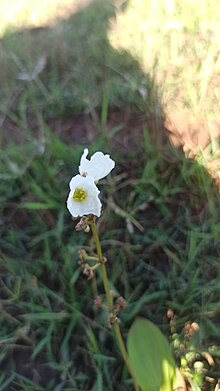| Echinodorus longiscapus | |
|---|---|

| |
| Scientific classification | |
| Kingdom: | Plantae |
| Clade: | Tracheophytes |
| Clade: | Angiosperms |
| Clade: | Monocots |
| Order: | Alismatales |
| Family: | Alismataceae |
| Genus: | Echinodorus |
| Species: | E. longiscapus
|
| Binomial name | |
| Echinodorus longiscapus Archavaleta
| |
| Synonyms[1] | |
| |
Echinodorus longiscapus is a perennial, aquatic plant of the Alismataceae, native to South America (Brazil, Paraguay, Uruguay and Argentina).[1] It is cultivated as a pond or aquarium plant.
Description
[edit]Leaves long-petioled, petioles 1.5 - 3 x longer than the blades. Blades oval, ovate or cordate, at the tip obtuse or shortly acuminate, at the base lobate or abrupt, 9 – 11 cm long x 7 – 8 cm wide, in the terrestrial forms often only 3 cm long x 2 cm wide. Submersed blades oval or ovate, often nearly rounded. Blades trimmed with pellucid lines to 2 mm long. Stem erect, longer than the leaves, glabrous or rarely scabrous, 30 – 80 cm long. Inflorescence racemose having 3 - 9 whorls containing 6 - 12 flowers each, proliferous. Bracts as long as the pedicels, or hardly longer, to 1.5 cm long, having 9 - 11 ribs and membraneous margins. Pedicels usually 1 - (2.5) cm long, sepals 5 – 6 mm long having 16 - 20 undistinct ribs, petals white, 1.7 – 2 cm long, corolla 2.5 – 4 cm in diameter. Stamens 20 - 25, anthers as long as the filaments, pistils numerous. Aggregate fruit globular or ovate, 5 – 7 mm in diameter. Achenes 2 - 2.3 mm long x 0.9 – 1 mm wide having usually 4 lateral ribs and (1) - 3 glands placed in a row in the upper half of the body. Beak erect or bent, 0.5 mm long.[2][3][4]
Cultivation
[edit]Propagated by division or adventitious plantlets. Seeds germinate freely. Easy to cultivate and seems to withstand a wide range of water conditions and temperatures.[citation needed]
References
[edit]- ^ a b "World Checklist of Selected Plant Families: Royal Botanic Gardens, Kew". apps.kew.org. Retrieved 2017-01-27.
- ^ Arechavaleta y Balpardo, José. 1903. Anales del Museo Nacional de Montevideo 4(1): 67–68, t. 2
- ^ Rataj, K. 1969. Echinodorus longiscapus Arech. y su dispersión en la América latina. Darwiniana 15:183–188.
- ^ Caccavari, M. 1983. Boletín de la Sociedad Argentina de Botánica 22(1–4): 247, figs. 1–2.